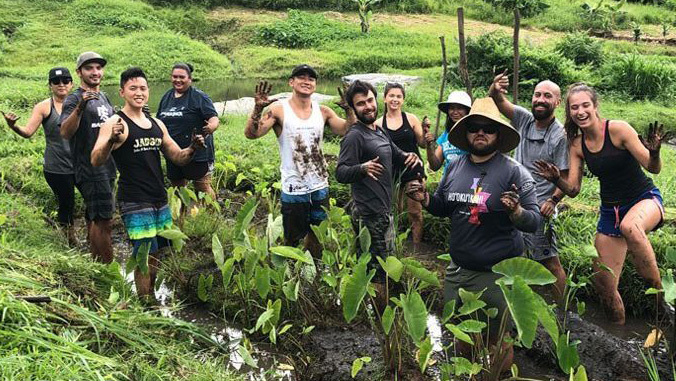A version of this story was originally published on July 30, 2020 in Kai Wai Ola, the monthly newspaper of the Office Hawaiian Affairs.
Community health programs at the University of Hawaiʻi at Mānoa John A. Burns School of Medicine (JABSOM) were hit hard by COVID-19 as many of them involved first-year medical students going into local communities to conduct service-learning activities. However, medical students enrolled in “Native Hawaiian Health Past, Present, Future” in the spring turned it into an opportunity and created educational COVID-19 videos in both English and ʻōlelo Hawaiʻi (Hawaiian language).
Instead of putting together an in-person health lesson plan for their annual visit to Ke Kula ʻo Samuel M. Kamakau, a Hawaiian language immersion public charter school, students in the JABSOM course created relevant health education videos.
- General COVID-19 Overview
- Proper Handwashing
- Masking and Social Distancing
- Staying Active at Home, an exercise video that includes a yoga session
The videos were completed using the English language and translated into Hawaiian for students at Kamakau, thanks to volunteer translators contributing many hours to kōkua and truly making the project a community effort.
Supporters at Kamakau, Ānuenue Public Charter School and UH Mānoa recruited family and friends to help. The end result is a collection of four videos, each with two different versions: one in English and the other with either Hawaiian voice-overs or Hawaiian subtitles.
The nine students enrolled in the course were: Kamuela Andrade, Abigail Bautista, Alyssa Becker, Amelia Hummel, James DeJesus IV, Elliot Koshi, Jason Lee, Jenna Maligro and Trevor McCracken. Maligro, a medical student, and LeShay Keliʻiholokai, JABSOM Native Hawaiian Center of Excellence research assistant, were editors for the project.
While the videos involved a lot of hard work and creativity, the project was a worthwhile endeavor. “The video project was a great opportunity for me to do something fun with my own keiki while teaching them a little about the current pandemic,” said Andrade. “And when the final touches were made by our editors and the great young ʻōlelo speakers, the videos came out even better than we expected. It was really a team collaboration all the way around and my family and I were just happy to be a part of it.”
“The process of making educational videos for the keiki about COVID-19 was fun, yet challenging,” added Maligro. “I enjoyed the creative process and figuring out entertaining ways to present relevant information. During this pandemic, our responsibility as medical students is to provide knowledge and education to our community. This project gave us an opportunity to play a role in educating our keiki about COVID-19, while having fun along the way.”
Faculty and students at JABSOM are excited to release the educational videos to schools as the new school year begins, and are proud to offer ʻōlelo Hawaiʻi versions, as well.
The videos are being shared with the Hawaiʻi Department of Health, Department of Education, the COVID-19 Joint Information Center, Hawaiʻi Emergency Management Agency and other entities.
Read more and view the full set of videos.
—By Martina L. Kamaka


